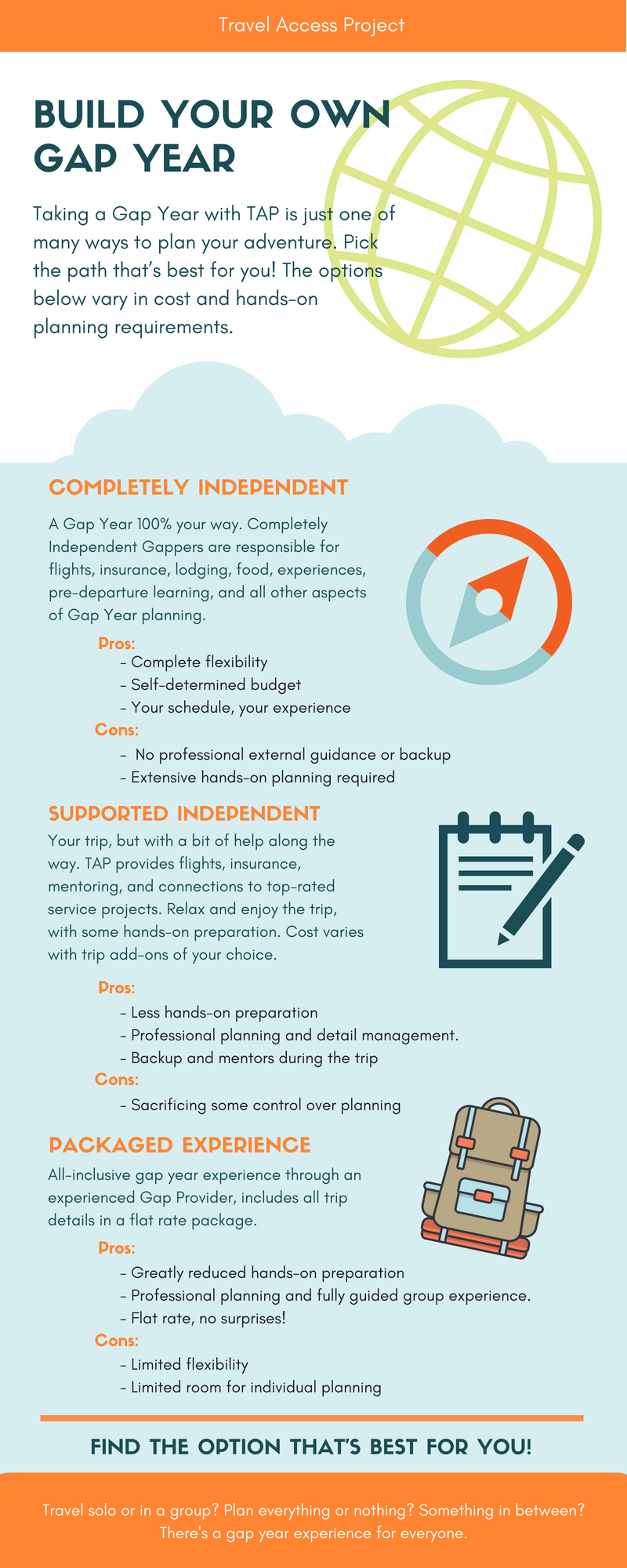Increasingly there is apprehension as a high school student approaches graduation. The costs of higher education are rising. The statistics regarding the number of college graduates who cannot find employment in their fields is disturbing. More and more young people are unsure of what they want to study and are questioning the path forward after graduation.
Traditionally, we’ve pushed our promising students from high school to university to prepare them for a well-paying career. However, as the world continues to change and the workforce with it, the tried and true path is no longer, well, tried and true.
Data tells us that many graduating seniors are not prepared for the university environment and don’t have clear direction as to their career path. It doesn’t make a lot of sense to dive into a degree program with a price tag of tens of thousands of dollars per year without knowing if it’s the right path.
What’s the alternative? A gap year.
 Photo by Nicola Nuttall on Unsplash
Photo by Nicola Nuttall on Unsplash
Gap years are common in other countries, across Europe and Australia. It is a year taken, typically, to travel, explore interests and build an education outside of the classroom. It is a year for students who are often burned out on the traditional education process to recharge their batteries, figure out what it is that they might like to do, and learn in experiential ways. Does it have to be a whole year? No, of course not. A gap experience might be as short as three months, or a semester. Or, it could be an entire academic year in the world.
Planning a Gap Year can be a big undertaking.
Making the decision to take a year between high school and college, or university and career, and taking your educational experience into your own hands for that time feels daunting. Where do you start? What are the options? How do you know you haven’t missed some big thing that’s going to derail your trip later on?
There are many details to organize and lots of things to consider in planning a Gap Year, and many of them are so unique that making “one size fits all” recommendations doesn’t work very well. If you’re serious about taking a Gap Year, then starting to plan at least a year in advance is wise.
There are three basic ways that people take a Gap Year:
Either they go with a program, finding a packaged deal that includes everything, including daily support through an on the ground leader, with a group, or they plan the entire trip independently, often with the help of family or well-traveled friends. The third path is a hybrid that offers the best of both worlds, the supported independent Gap Year.
Here’s a breakdown of the options:

Independent
If you aren’t particularly interested in participating in a program, then you can always take the independent route. Independently organized Gap Years tend to be less expensive, they can be more tailored to your individual goals, and they provide endless opportunities to make adjustments and change things up on the fly if you find circumstances changing throughout your year.

Going the independent route means that you’re taking responsibility for every single aspect of your Gap Year yourself.
Programs
Many young people who take a Gap Year do so through a program. There are dozens of them out there, from truly off the grid, outback survival excursions, to international volunteer experiences, to deep cultural immersion adventures, and domestic service programs right here at home. Starting your Gap Year with a program is a great way to build your skills and confidence as you set out into the world on your own. The Gap Year Association recommends the ideal Gap Year breakdown as equal parts structured program and independent internship or travel.
With so many programs to choose from, how do you decide which one is right for you?
- Look for core value alignment; does the organization believe what you do?
- Look for something that excites you
- Look for something that will stretch you
- Do your homework, ask for referrals and references, research the experiences of other
Be prepared for sticker shock. Gap Year programs tend to be expensive, about the same as a year of university.
Supported Independent
Your Gap Year doesn’t have to be all or nothing. It’s not a binary choice between an expensive, supported program, or a completely on your own adventure. For many students, the “sweet spot” is in a supported, yet independent Gap Year.
![]() Photo by rawpixel on Unsplash
Photo by rawpixel on Unsplash
What does that mean? Well, it means that you control the reins, but there is help with the logistics and your pre-departure planning and education.
If you love the idea of a Gap Year but you don’t know where to start, or the logistics seem overwhelming, then you should consider getting the right kind of help through a program like TAP GAPS.
Travel Access Project Gap Programs allow students (of any age, nationality, or background) to chart their own courses by choosing and applying to an ethical service-learning program through Omprakash. But then we provide help with all of the planning and details.
What’s included:
- Roundtrip airfare through AirTreks
- Insurance
- Food and lodging
- Ethical service learning opportunity
- Pre-departure travel planning support
- Pre-departure education to prepare you to travel
- Student membership in the Gap Year Association
$4995 covers the whole ball of wax, with the expert support of our travel mentors who have years of experience in independent and student travel. That’s less than half of the cost of a semester with a programmatic Gap Year.
If you’re interested in planning a Gap Year but would like a little help, shoot us an email and let us help!